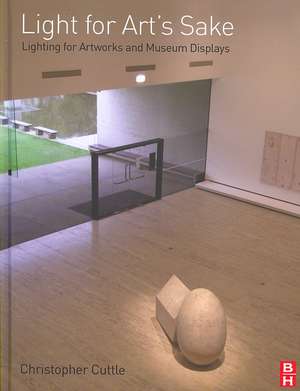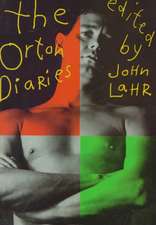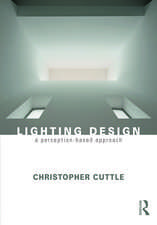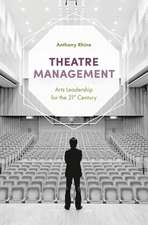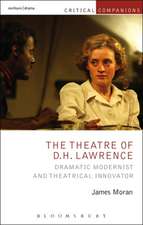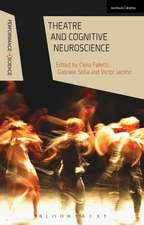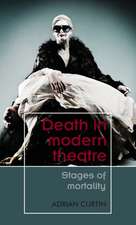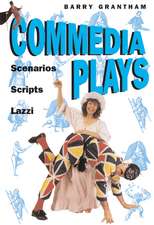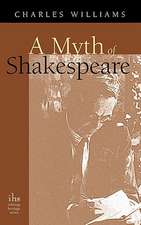Light for Art's Sake: Lighting for Artworks and Museum Displays
Autor Christopher Cuttleen Limba Engleză Hardback – 26 mar 2007
Rather than portraying conservation and display as having diametrically opposed objectives, the central concept is that the interaction of light and art media is the source for both the visual experience and the degradation of the artwork. Optimal solutions derive from understanding and controlling the interaction process, and the need is for the level of understanding among lighting professionals to be brought closer to that found among conservation scientists.
Preț: 940.31 lei
Preț vechi: 1033.31 lei
-9% Nou
Puncte Express: 1410
Preț estimativ în valută:
179.95€ • 186.73$ • 150.41£
179.95€ • 186.73$ • 150.41£
Carte disponibilă
Livrare economică 22 februarie-08 martie
Livrare express 08-14 februarie pentru 50.16 lei
Preluare comenzi: 021 569.72.76
Specificații
ISBN-13: 9780750664301
ISBN-10: 0750664304
Pagini: 288
Ilustrații: Illustrations
Dimensiuni: 192 x 252 x 24 mm
Greutate: 1.01 kg
Editura: BUTTERWORTH HEINEMANN
ISBN-10: 0750664304
Pagini: 288
Ilustrații: Illustrations
Dimensiuni: 192 x 252 x 24 mm
Greutate: 1.01 kg
Editura: BUTTERWORTH HEINEMANN
Public țintă
Readership (primary):Museum professionals, exhibition designers, specialist lighting designers
Readership (secondary):
Conservators, architects
Cuprins
Preface
Acknowledgments
Introduction
Chapter One: A philosophy for the presentation of art
Chapter Two: Revealing visual attributes
2.1 Light and illumination
2.2 Human response to light
2.3 Light levels in museums
2.4 Revealing with light
Chapter Three: Light-induced damage to objects
3.1 Photochemical reactions
3.2 Radiant heating effect
3.3 Material response to exposure
3.4 Limiting exposure
Chapter Four: Daylighting typologies
4.1 The aesthetics of daylight
4.2 Side-lit rooms
4.3 Monitor skylights
4.4 Central skylight picture galleries
4.5 Overall daylight-diffusing ceilings
4.6 Restricted daylight-diffusing ceilings
4.7 Polar-oriented skylights
4.8 Wall-lighting picture galleries
4.9 The presence of daylight
Chapter Five: Daylighting controls
5.1 Light transmission
5.2 Light distribution
5.3 Ultraviolet transmission
5.4 Solar heat gain
5.5 Thermal transmission
Chapter Six: Electric lighting typologies
6.1 The aesthetics of electric lighting
6.2 Room surface lighting
6.3 Lighting three-dimensional objects
6.4 Lighting two-dimensional objects
6.5 Case lighting
6.6 Supplementing daylight
6.7 Self-luminous art objects
Chapter Seven: Electric lighting controls
7.1 Light output control
7.2 Luminaire optical control
7.3 Luminaire directional control
7.4 Lighting control systems
Chapter Eight: Lighting strategies
8.1 Ambient illumination
8.2 A sequence of visual experiences
8.3 Minimal-exposure displays
8.4 The great space
8.5 Visual connections
Chapter Nine: Procedures for practice
9.1 A museum lighting pro forma
9.2 Setting up lighting for a new exhibition
9.3 Maintaining lighting during the life of an exhibition
References
Bibliography
Index
Acknowledgments
Introduction
Chapter One: A philosophy for the presentation of art
Chapter Two: Revealing visual attributes
2.1 Light and illumination
2.2 Human response to light
2.3 Light levels in museums
2.4 Revealing with light
Chapter Three: Light-induced damage to objects
3.1 Photochemical reactions
3.2 Radiant heating effect
3.3 Material response to exposure
3.4 Limiting exposure
Chapter Four: Daylighting typologies
4.1 The aesthetics of daylight
4.2 Side-lit rooms
4.3 Monitor skylights
4.4 Central skylight picture galleries
4.5 Overall daylight-diffusing ceilings
4.6 Restricted daylight-diffusing ceilings
4.7 Polar-oriented skylights
4.8 Wall-lighting picture galleries
4.9 The presence of daylight
Chapter Five: Daylighting controls
5.1 Light transmission
5.2 Light distribution
5.3 Ultraviolet transmission
5.4 Solar heat gain
5.5 Thermal transmission
Chapter Six: Electric lighting typologies
6.1 The aesthetics of electric lighting
6.2 Room surface lighting
6.3 Lighting three-dimensional objects
6.4 Lighting two-dimensional objects
6.5 Case lighting
6.6 Supplementing daylight
6.7 Self-luminous art objects
Chapter Seven: Electric lighting controls
7.1 Light output control
7.2 Luminaire optical control
7.3 Luminaire directional control
7.4 Lighting control systems
Chapter Eight: Lighting strategies
8.1 Ambient illumination
8.2 A sequence of visual experiences
8.3 Minimal-exposure displays
8.4 The great space
8.5 Visual connections
Chapter Nine: Procedures for practice
9.1 A museum lighting pro forma
9.2 Setting up lighting for a new exhibition
9.3 Maintaining lighting during the life of an exhibition
References
Bibliography
Index
Recenzii
"Light for Art's Sake is a well thought, through publication and it will form a valuable element for museum and art gallery designers. But it will also be a valuable text for all students of lighting - young and old."
David Loe, Lighting Research & Technology
David Loe, Lighting Research & Technology
Notă biografică
Christopher Cuttle
